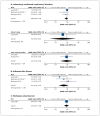Effectiveness of N95 respirators versus surgical masks in protecting health care workers from acute respiratory infection: a systematic review and meta-analysis
- PMID: 26952529
- PMCID: PMC4868605
- DOI: 10.1503/cmaj.150835
Effectiveness of N95 respirators versus surgical masks in protecting health care workers from acute respiratory infection: a systematic review and meta-analysis
Abstract
Background: Conflicting recommendations exist related to which facial protection should be used by health care workers to prevent transmission of acute respiratory infections, including pandemic influenza. We performed a systematic review of both clinical and surrogate exposure data comparing N95 respirators and surgical masks for the prevention of transmissible acute respiratory infections.
Methods: We searched various electronic databases and the grey literature for relevant studies published from January 1990 to December 2014. Randomized controlled trials (RCTs), cohort studies and case-control studies that included data on health care workers wearing N95 respirators and surgical masks to prevent acute respiratory infections were included in the meta-analysis. Surrogate exposure studies comparing N95 respirators and surgical masks using manikins or adult volunteers under simulated conditions were summarized separately. Outcomes from clinical studies were laboratory-confirmed respiratory infection, influenza-like illness and workplace absenteeism. Outcomes from surrogate exposure studies were filter penetration, face-seal leakage and total inward leakage.
Results: We identified 6 clinical studies (3 RCTs, 1 cohort study and 2 case-control studies) and 23 surrogate exposure studies. In the meta-analysis of the clinical studies, we found no significant difference between N95 respirators and surgical masks in associated risk of (a) laboratory-confirmed respiratory infection (RCTs: odds ratio [OR] 0.89, 95% confidence interval [CI] 0.64-1.24; cohort study: OR 0.43, 95% CI 0.03-6.41; case-control studies: OR 0.91, 95% CI 0.25-3.36); (b) influenza-like illness (RCTs: OR 0.51, 95% CI 0.19-1.41); or (c) reported workplace absenteeism (RCT: OR 0.92, 95% CI 0.57-1.50). In the surrogate exposure studies, N95 respirators were associated with less filter penetration, less face-seal leakage and less total inward leakage under laboratory experimental conditions, compared with surgical masks.
Interpretation: Although N95 respirators appeared to have a protective advantage over surgical masks in laboratory settings, our meta-analysis showed that there were insufficient data to determine definitively whether N95 respirators are superior to surgical masks in protecting health care workers against transmissible acute respiratory infections in clinical settings.
© 2016 Canadian Medical Association or its licensors.
Figures


References
-
- Routine practices and additional precautions: in all health care settings, 3rd ed. In: Ontario Agency for Health Protection and Promotion, Provincial Infectious Diseases Advisory Committee. Toronto: Queen’s Printer for Ontario; 2012. Available: www.publichealthontario.ca/en/eRepository/RPAP_All_HealthCare_Settings_E... (accessed 2014 Dec. 12).
-
- Infection prevention and control of epidemic- and pandemic-prone acute respiratory infections in health care. Geneva: World Health Organization; 2014. Available: www.who.int/csr/bioriskreduction/infection_control/publication/en/ (accessed 2014 Dec. 9). - PubMed
-
- Brankston G, Gitterman L, Hirji Z, et al. Transmission of influenza A in human beings. Lancet Infect Dis 2007;7:257–65. - PubMed
Publication types
MeSH terms
LinkOut - more resources
Full Text Sources
Other Literature Sources
Medical
